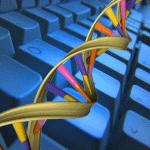Bioinformatics
|
12 august 2015 11:06:08 |
| Thermodynamics of A?16-21 dissociation from a fibril: Enthalpy, entropy, and volumetric properties (Proteins: Structure, Function, and Bioinformatics) |
|
Tweet Here, we provide insights into the thermodynamic properties of A?16-21 dissociation from an amyloid fibril using all-atom molecular dynamics simulations in explicit water. An umbrella sampling protocol is used to compute potentials of mean force (PMF) as a function of the distance ? between centers-of-mass of the A?16-21 peptide and the preformed fibril at nine temperatures. Changes in the enthalpy and the entropic energy are determined from the temperature dependence of these PMF(s) and the average volume of the simulation box is computed as a function of ?. We find that the PMF at 310 K is dominated by enthalpy while the entropic energy does not change significantly during dissociation. The volume of the system decreases during dissociation. Moreover, the magnitude of this volume change also decreases with increasing temperature. By defining dock and lock states using the solvent accessible surface area (SASA), we find that the behavior of the electrostatic energy is different in these two states. It increases (unfavorable) and decreases (favorable) during dissociation in lock and dock states, respectively, while the energy due to Lennard-Jones interactions increases continuously in these states. Our simulations also highlight the importance of hydrophobic interactions in accounting for the stability of A?16-21. This article is protected by copyright. All rights reserved. |
| 129 viewsCategory: Biochemistry, Bioinformatics |
 Topological and sequence information predict that foldons organize a partially overlapped and hierarchical structure (Proteins: Structure, Function, and Bioinformatics) Topological and sequence information predict that foldons organize a partially overlapped and hierarchical structure (Proteins: Structure, Function, and Bioinformatics)Dynamics and thermodynamic properties of CXCL7 chemokine (Proteins: Structure, Function, and Bioinformatics) 
|
| blog comments powered by Disqus |
MyJournals.org
The latest issues of all your favorite science journals on one page
The latest issues of all your favorite science journals on one page



